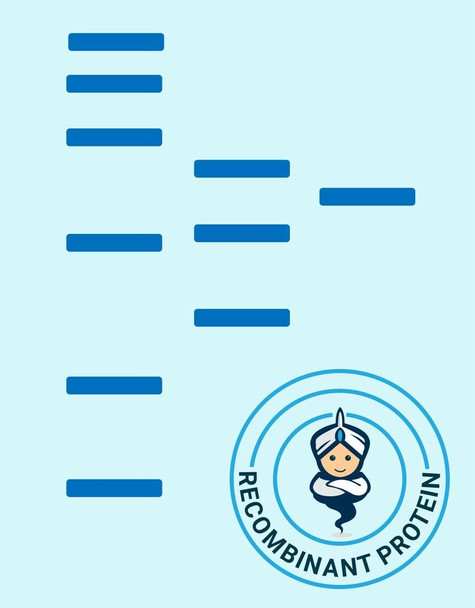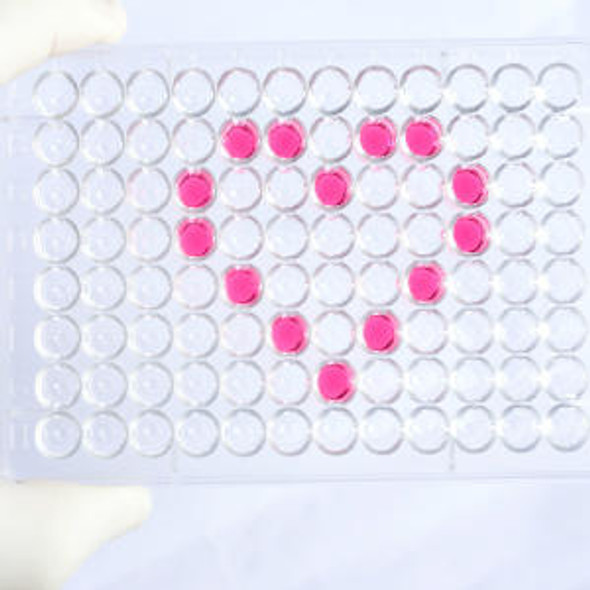Human DTNBP1 Recombinant Protein (RPPB3378)
- SKU:
- RPPB3378
- Product type:
- Recombinant Protein
- Size:
- 20ug
- Species:
- Human
- Target:
- DTNBP1
- Synonyms:
- Dysbindin
- SDY
- DBND
- HPS7
- Source:
- Escherichia Coli
- Uniprot:
- Q96EV8
Description
| Product Name: | Human DTNBP1 Recombinant Protein |
| Product Code: | RPPB3378 |
| Size: | 20µg |
| Species: | Human |
| Target: | DTNBP1 |
| Synonyms: | Dysbindin, SDY, DBND, HPS7, My031, FLJ30031, MGC20210, DKFZp564K192, Dystrobrevin-binding protein 1, Hermansky-Pudlak syndrome 7 protein homolog, Hps7-like protein, DTNBP1. |
| Source: | Escherichia Coli |
| Physical Appearance: | Sterile Filtered colorless solution. |
| Formulation: | The DTNBP1 solution contains 20mM Tris pH-8, 0.5mM DTT, 0.1M NaCl, and 20% glycerol. |
| Stability: | Store at 4°C if entire vial will be used within 2-4 weeks. Store, frozen at -20°C for longer periods of time. For long term storage it is recommended to add a carrier protein (0.1% HSA or BSA).Avoid multiple freeze-thaw cycles. |
| Purity: | Greater than 95.0% as determined by SDS-PAGE. |
| Amino Acid Sequence: | MRGSHHHHHH GMASMTGGQQ MGRDLYDDDD KDRWGSHMLS AHWEKKKTSL VELQEQLQQL PALIADLESM TANLTHLEAS FEEVENNLLHLEDLCGQCEL ERCKHMQSQQ LENYKKNKRK ELETFKAELD AEHAQKVLEM EHTQQMKLKE RQKFFEEAFQ QDMEQYLSTG YLQIAERREP IGSMSSMEVN VDMLEQMDLM DISDQEALDV FLNSGGEENT VLSPALGPES STCQNEITLQ VPNPSELRAK PPSSSSTCTD SATRDISEGG ESPVVQSDEE EVQVDTALAT SHTDREATPD GGEDSDS |
DTNBP1 is involved in organelle biogenesis connected with melanosomes, platelet dense granules, and lysosomes. An analogous protein in murine is a part of a protein complex called BLOC-1, and connects to alpha- and beta-dystrobrevins, which are factors of the dystrophin-associated protein complex (DPC). Mutations in DTNBP1 gene are associated with Hermansky-Pudlak syndrome type 7. DTNBP1 gene may also be associated with schizophrenia.
DTNBP1 Human Recombinant fused to 37 a.a. N-terminal His-Tag produced in E.Coli is a single, non-glycosylated polypeptide chain containing 307 amino acids (1-270a.a.) and having a molecular mass of 34.6 kDa.
| UniProt Protein Function: | DTNBP1: The BLOC-1 complex is required for normal biogenesis of lysosome-related organelles, such as platelet dense granules and melanosomes. Plays a role in intracellular vesicle trafficking. Plays a role in synaptic vesicle trafficking and in neurotransmitter release. May be required for normal dopamine homeostasis in the cerebral cortex, hippocampus, and hypothalamus. Plays a role in the regulation of cell surface exposure of DRD2. Contributes to the regulation of dopamine signaling. May play a role in actin cytoskeleton reorganization and neurite outgrowth. May modulate MAPK8 phosphorylation. Part of the biogenesis of lysosome-related organelles complex 1 (BLOC-1). The BLOC-1 complex is composed of BLOC1S1, BLOC1S2, BLOC1S3, DTNBP1, MUTED, PLDN, CNO/cappuccino and SNAPIN. Binds to DTNA and DTNB but may not be a physiological binding partner (PubMed:16980328). Interacts with RNF151 and CMYA5. Identified in a complex with the adapter-related protein complex 3 (AP-3). Interacts with TRIM32, AP3M1 and AP3B2. Identified in a complex with the biogenesis of lysosome-related organelles complex 2 (BLOC-2). Interacts with the DNA-dependent protein kinase complex DNA-PK. Detected in brain, in neurons and in neuropil. Detected in dentate gyrus and in pyramidal cells of hippocampus CA2 and CA3. Belongs to the dysbindin family. 2 isoforms of the human protein are produced by alternative splicing. |
| UniProt Protein Details: | Protein type:Vesicle Chromosomal Location of Human Ortholog: 6p22.3 Cellular Component: endoplasmic reticulum membrane; neuron projection; synaptic vesicle membrane; melanosome membrane; postsynaptic density; dendritic spine; cytosol; postsynaptic membrane; growth cone; axon; cytoplasm; endosome membrane; nucleus; sarcoplasm; cell junction; sarcolemma Molecular Function:protein binding Biological Process: platelet dense granule organization and biogenesis; melanosome organization and biogenesis; regulation of dopamine receptor signaling pathway; actin cytoskeleton reorganization; anterograde synaptic vesicle transport; post-Golgi vesicle-mediated transport; blood coagulation; anterograde axon cargo transport; positive regulation of neurotransmitter secretion; regulation of dopamine secretion; neurite development; neurite morphogenesis Disease: Schizophrenia; Hermansky-pudlak Syndrome 7 |
| NCBI Summary: | This gene encodes a protein that may play a role in organelle biogenesis associated with melanosomes, platelet dense granules, and lysosomes. A similar protein in mouse is a component of a protein complex termed biogenesis of lysosome-related organelles complex 1 (BLOC-1), and binds to alpha- and beta-dystrobrevins, which are components of the dystrophin-associated protein complex (DPC). Mutations in this gene are associated with Hermansky-Pudlak syndrome type 7. This gene may also be associated with schizophrenia. Multiple transcript variants encoding distinct isoforms have been identified for this gene. [provided by RefSeq, Jul 2008] |
| UniProt Code: | Q96EV8 |
| NCBI GenInfo Identifier: | 38604971 |
| NCBI Gene ID: | 84062 |
| NCBI Accession: | Q96EV8.1 |
| UniProt Related Accession: | Q96EV8 |
| Molecular Weight: | 30kDa; 34kDa; 39kDa |
| NCBI Full Name: | Dysbindin |
| NCBI Synonym Full Names: | dystrobrevin binding protein 1 |
| NCBI Official Symbol: | DTNBP1 |
| NCBI Official Synonym Symbols: | SDY; DBND; HPS7; My031; BLOC1S8 |
| NCBI Protein Information: | dysbindin |
| UniProt Protein Name: | Dysbindin |
| UniProt Synonym Protein Names: | Biogenesis of lysosome-related organelles complex 1 subunit 8; BLOC-1 subunit 8; Dysbindin-1; Dystrobrevin-binding protein 1; Hermansky-Pudlak syndrome 7 protein; HPS7 protein |
| Protein Family: | Dysbindin |
| UniProt Gene Name: | DTNBP1 |
| UniProt Entry Name: | DTBP1_HUMAN |










